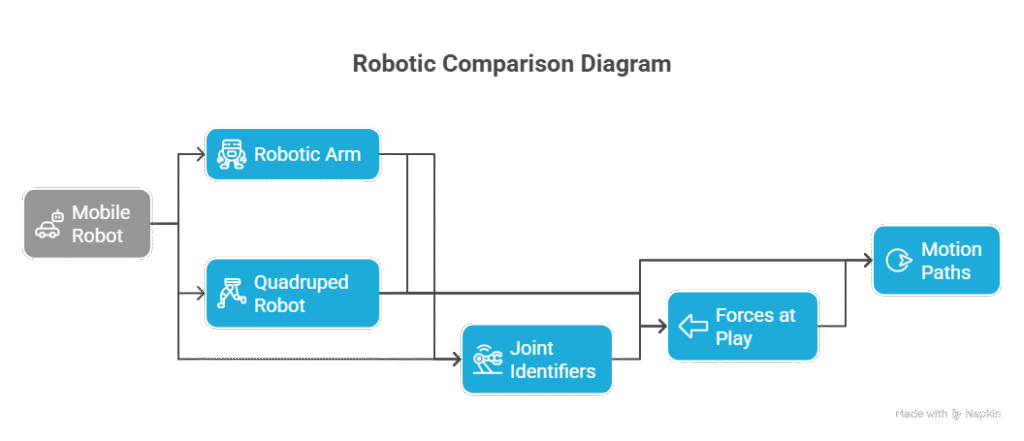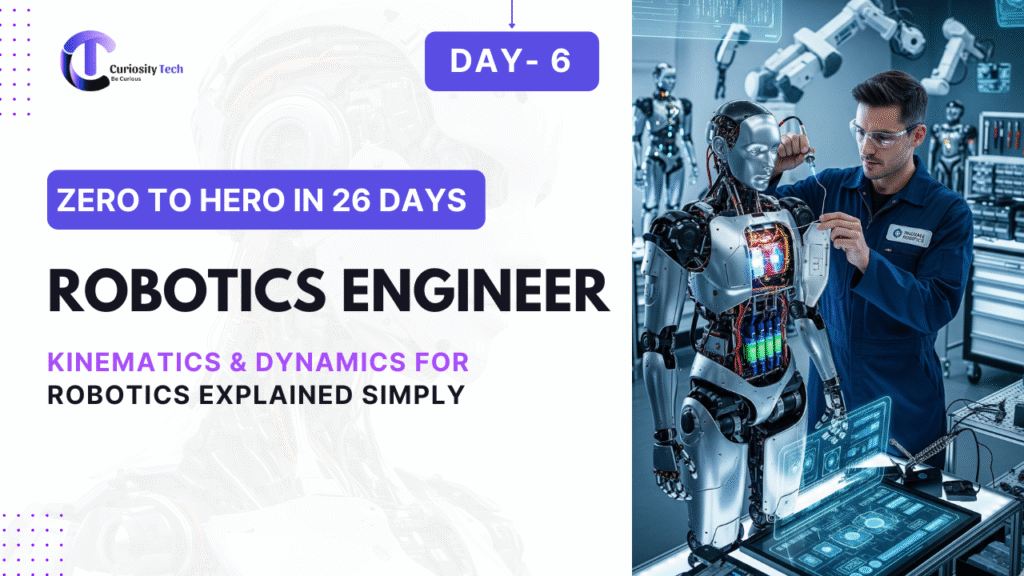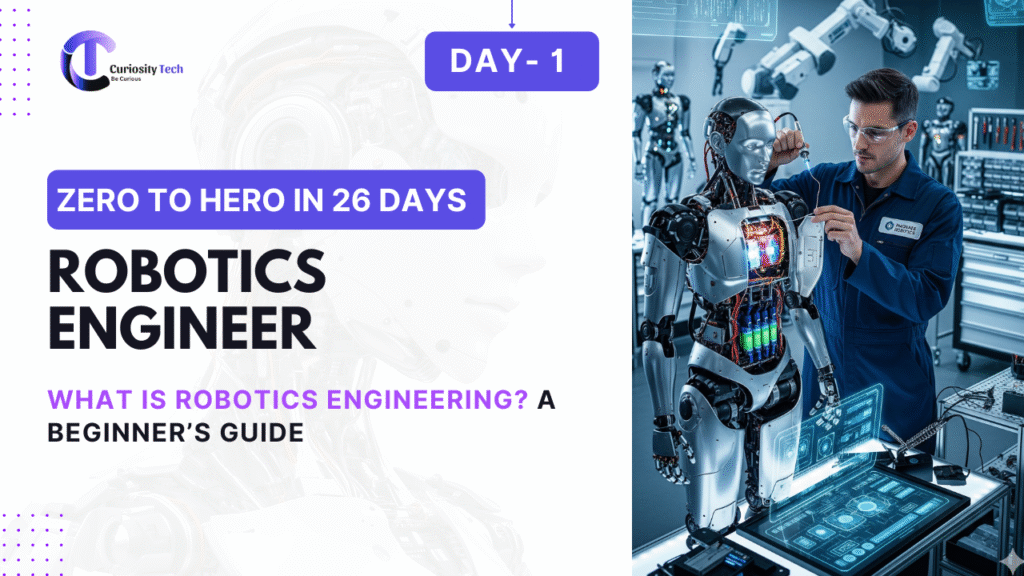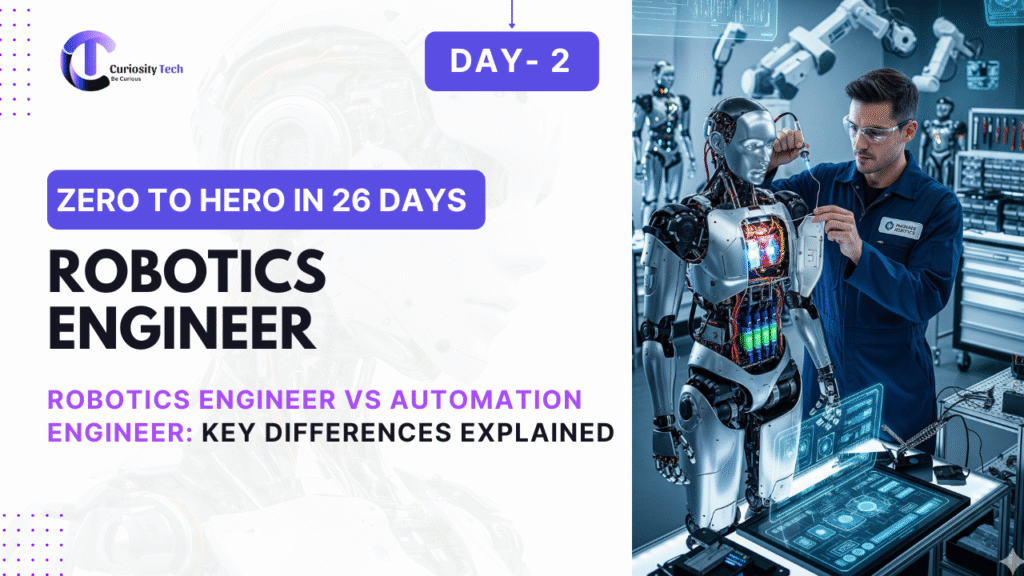Introduction
To make robots move accurately and efficiently, understanding kinematics and dynamics is essential. While these concepts originate in classical mechanics, their application in robotics is highly specialized. Robotics engineers use kinematics and dynamics to model robot motion, design manipulators, and control autonomous movement.
At curiositytech.in beginners and professionals alike can explore tutorials and simulations to visualize and implement kinematic and dynamic principles in real robots.
1. What is Kinematics in Robotics?
Kinematics is the study of motion without considering the forces that cause it. In robotics, kinematics helps determine position, velocity, and acceleration of a robot or its joints.
Types of Kinematics
- Forward Kinematics (FK):
- Determines the end-effector’s position given joint parameters.
- Use Case: Calculating where a robotic arm will reach based on joint angles.
- Determines the end-effector’s position given joint parameters.
Equation Example:
X = L1*cos(θ1) + L2*cos(θ1+θ2)
Y = L1*sin(θ1) + L2*sin(θ1+θ2)
- Where L1, L2 are link lengths, θ1, θ2 are joint angles.
- Inverse Kinematics (IK):
- Determines joint angles required to reach a specific point.
- Use Case: Positioning a robotic arm to pick objects.
- Algorithm Example: Iterative numerical methods like Jacobian inverse or gradient descent.
- Determines joint angles required to reach a specific point.
2. What is Dynamics in Robotics?
Dynamics considers forces and torques that cause motion. It’s crucial for robot stability, energy efficiency, and precision control.
Dynamics Components
- Newton-Euler Method: Calculates forces and torques for each link using recursive formulas.
- Lagrangian Method: Energy-based approach using kinetic and potential energy.
- Useful for multi-degree-of-freedom robots.
- Useful for multi-degree-of-freedom robots.
- Applications:
- Controlling robotic arms under variable loads.
- Optimizing energy use for mobile robots.
- Designing legged robots for smooth locomotion.
- Controlling robotic arms under variable loads.
Table: Kinematics vs Dynamics
| Aspect | Kinematics | Dynamics |
| Focus | Motion without forces | Motion with forces and torques |
| Output | Position, velocity, acceleration | Force, torque required |
| Application | Robot arm trajectory, navigation | Motor torque calculation, stability control |
| Complexity | Low to Moderate | Moderate to High |
3. Types of Robots & Motion Analysis
A. Mobile Robots
- Kinematics: Uses wheel velocities and robot geometry to determine trajectory.
- Dynamics: Forces from wheels, friction, and torque requirements.
- Example: Differential-drive robot calculations for straight-line and turning motion.
B. Manipulator Arms
- Kinematics: Forward and inverse kinematics for end-effector positioning.
- Dynamics: Torque calculations for each joint considering payload and acceleration.
- Example: Industrial 6-DOF robot arm used in assembly lines.
C. Legged Robots
- Kinematics: Gait planning for multi-legged motion.
- Dynamics: Force distribution for stability, jumping, or walking on uneven terrain.

4. Real-World Applications
- Industrial Robots: Use kinematics and dynamics for precise assembly, welding, or painting.
- Autonomous Vehicles: Dynamics help in trajectory planning, braking, and acceleration control.
- Humanoid Robots: Balance, walking, and grasping require deep dynamics computation.
- Drones: Flight stability and maneuvering rely on dynamics models considering thrust, drag, and inertia.
Practical Tip: Beginners can simulate 2D robot arms in CuriosityTech.in’s interactive tutorials, experimenting with FK and IK before moving to hardware.
5. Tools and Resources for Learning
- Simulation Software: Gazebo, V-REP, MATLAB Robotics Toolbox.
- Programming Libraries: ROS, MoveIt! for motion planning, OpenRAVE for kinematics.
- Mathematical Methods: Linear algebra, matrices, Jacobians, and differential equations.
- Hands-On Practice: Start with Arduino or Raspberry Pi robots to implement motion equations practically.
Skill Roadmap Table
| Skill Level | Focus Area | Tools/Resources |
| Beginner | Forward kinematics, basic joint movement | Arduino, MATLAB, simple 2D simulations |
| Intermediate | Inverse kinematics, basic dynamics | ROS, MoveIt!, Python simulations |
| Advanced | Multi-DOF manipulators, trajectory optimization, force control | MATLAB Robotics Toolbox, Gazebo, advanced manipulators |
6. Tips to Master Kinematics & Dynamics
- Visualize motion through simulation before hardware implementation.
- Solve numerical examples daily to strengthen intuition.
- Understand robot-specific constraints: wheel radius, joint limits, payload capacity.
- Experiment with real-world projects from platforms like curiositytech.in.
- Combine kinematics and dynamics knowledge with programming (C/C++, Python) for full control implementation.
Conclusion
Kinematics and dynamics form the backbone of robot motion planning and control. Mastering these topics enables robotics engineers to design, simulate, and control complex robots accurately. By combining theoretical understanding, simulations, and hands-on projects available on curiositytech.in learners can transform fundamental principles into real-world robotic applications.



